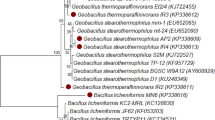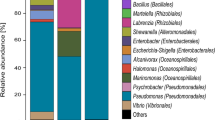Abstract
Five naphtha hydrocarbon-degrading bacteria including representative strains of the two classified species (Serratia marcescensAR1, Bacillus pumilusAR2, Bacillus carboniphilus AR3, Bacillus megaterium AR4, and Bacillus cereus AR5) were identified by 16S rDNA gene sequence in a naphtha-transporting pipeline. The naphtha-degrading strains were able to be involved in the corrosion process of API 5LX steel and also utilized the naphtha as the sole carbon source. The biodegradation of naphtha by the bacterial isolates was characterized by gas chromatography–mass spectrometry. Weight-loss measurement on the corrosion of API 5LX steel in the presence/absence of consortia grown in naphtha–water aqueous media was performed. The scanning electron microscope observation showed that the consortia were able to attack the steel API 5LX surface, creating localized corrosion (pit). The biodegradation of naphtha by the strains AR1, AR2, AR3, AR4, and AR5 showed biodegradation efficiency of about 76.21, 67.20, 68.78, 68.78, and 68.15, respectively. The role of degradation on corrosion has been discussed. This basic study will be useful for the development of new approaches for the detection, monitoring, and control of microbial corrosion in a petroleum product pipeline.



Similar content being viewed by others
References
Ausubel FM, Brent R, Kingston RE, Moore DD, Seidelman JG, Struhl. KE (1988) Current protocols in molecular biology. Wiley, New York
Bento FM, Gaylarde CC (2001) Bio-deterioration of stored diesel oil: studies in Brazil. Int Biodeterior Biodegrad 47:107–112
Buck E, Maddux GC, Sullivan RL (1996) Intern CORROSION COST IMPACT STUDY—United States natural gas exploration and production industry. GRI-96/0056 document No 96-1466. Gas Research Institute, Des Plaines, IL
Costerton JW, Boivin J (1987) Microbially influenced corrosion. In: Mittelman MW, Geesey GG (eds) Biological fouling of industrial water systems. A problem solving approach. Water Micro Associates, San Diego, CA, pp 56–76
Davis B (1967) Petroleum microbiology. Elsevier, New York, pp 62–68
Felsentein J (1993) PHYLIP (Phylogeny Inference Package) Version 3.5c. Department of Genetics, University of Washington, Seattle, WA
Gaylarde CC, Bento FM, Kelley J (1999) Microbial contamination of stored hydrocarbon fuels and its control: a mini-review. Rev Microbiol 30:1–10
Graves JW, Sullivan EH (1996) Internal corrosion in gas gathering system and transmission lines. Mater Protect 5:33–37
Hamilton WA (1985). Sulphate-reducing bacteria and anaerobic corrosion. Annu Rev Microbiol 39:195–217
Higgins IJ, Gilbert PD (1978) The oil industry and microbial ecosystem. In Chater KA, Somerville HJ (eds) Heyden and Sons, London, pp 52–58
Holt JG, Kreig NR, Sneath PHA, Stanely JT, Williams ST (1994) Bergey’s manual of determinative bacteriology. Williams & Wilkins, Baltimore, MD
Jana AK, Sahota SK, Dhawan HC (1999) Failure analysis of oil pipeline. Bull Electrochem 15:262–265
Jan-Roblero J, Romero JM, Amaya M, Le Borgne S (2004) Phylogenetic characterization of a corrosive consortium isolated from a sour gas pipeline. Appl Microbiol Biotehnol 64:862–867
Jobson AM (1975) Physiological characterization of Desulfovibrio sp isolated from crude oil, University of Alberta, Edmonton
Jones DA, Amy PS (2002) A thermodynamic interpretation of microbiologically influenced corrosion. Corrosion 58:638–645
Kimura MA (1980) Simple method for estimating evolutionary rates of base substitutions through comparative studies of nucleotide sequences. J Mol Evol 6:11–20
Koch GH, Brongers MPH, Thompson NG, Virmani YP, Payer JH (2001) Corrosion costs and preservative strategies in the United States FHWA-RD-01-156 (on-line). Federal Highway Administration, Washington, DC. Available from http://www.corrosioncost.com
Little B, Ray R (2002) A perspective on corrosion inhibition by biofilms. Corrosion 58:424–428
Michaud L, Lo Giudice A, Saitta M, De Domenico M, Vivia B (2004) The biodegradation efficiency on diesel oil by two psychrotrophic Antarctic marine bacteria during a two-month-long experiment. Marine Res Bull 49:405–409
Maruthamuthu S, Mohanan S, Rajasekar A, Muthukumar N, Ponmarippan S, Subramanian P, Palaniswamy N (2005) Role of corrosion inhibitors on bacterial corrosion in petroleum product pipeline. Indian J Chem Technol 12:567–575
Muthukumar N, Rajasekar A, Ponmarriappan S, Mohanan S, Maruthamuthu S, Muralidharan S, Subramanian P, Palaniswamy N, Raghavan M (2003) Microbiologically influenced corrosion in petroleum product pipelines: a review. Indian J Exp Biol 41:1012–1022
Muthukumar N, Mohanan S, Maruthamuthu S, Subramanian P, Palaniswamy N, Raghavan M (2003) Role of Gallionella sp and Brucella sp in oil degradation and corrosion. Electrochem Commun 5:421–425
Pope DH, Pope RM (1998) Guide for the monitoring and treatment of microbiologically induced corrosion in the natural gas industry. GRI report GRI-96/0488. Gas Research Institute, Des Plaines, IL
Rahman K. Thahira SM, Rahman J, Kourkoutas Y, Petsas I, Marchant R, Banat IM (2003) Enhanced bioremediation of n-alkane in petroleum sludge using bacterial consortium amended with rhamnolipid and micronutrients. Biores Technol 90:159–168
Rajasekar A, Maruthamuthu S, Muthukumar N, Mohanan S, Subramanian P, Palaniswamy N (2005) Bacterial degradation of naphtha and its influence on corrosion. Corros Sci 47:257–271
Rajasekar A, Maruthamuthu S, Palaniswamy N, Rajendran A (2006) Role of corrosion inhibitor degradation and its influence on corrosion. Microbiol Res (in press)
Rajasekar A, Ganesh Babu T, Maruthamuthu S, Karutha Pandian S, Mohanan S, Palaniswamy N (2006) Biodegradation and corrosion behavior of Serratia marcescens ACE2 isolated from Indian-diesel transporting pipeline. World J Microbiol Biotechnol (in press)
Van Beilen JB, Wubbolts MG, Witholt WE (1994) Genetic of alkane oxidation by Pseudomonas oleovorans. Biodegradation 5:161–174
Von Wolzogen Kuhr CAH, Vander KlugtWater IS (1934) The graphitization of cast iron as an electrochemical process in anaerobic solid. Water 18:147–165
Voordouw GJK, Voordouw TR, Jack J, Foght P, Fedorak M, Westlake DWS (1992) Identification of distinct communities of sulfate reducing bacteria in oil fields by reverse sample genome probing. Appl Environ Microbiol 58:3542–3552
Weisburg WG, Barns SM, Pelletier DA, Lane DJ (1991) 16S ribosomal DNA for phylogenetic study. J Bacteriol 173:697–703
Whyte LG, Hawari J, Zhou E, Bourbonniere L, Inniss WE, Greer CW (1998) Biodegradation of variable-chainlength alkanes at low temperatures by a psychrotrophic Rhodococcus sp, Appl Environ Microbiol 64:2578–2584
Wongsa P, Tanaka M, Ueno A, Hasanuzzaman M, Yumoto I, Okuya H (2004) Isolation and characterization of novel strains of Pseudomonas aeruginosa and Serratia marcescens possessing high efficiency to degrade gasoline, kerosene, diesel oil, and lubricating oil. Curr Microbiol 49(6):415–422
Zhu XY, Lubeck J, Kilbane JJ (2003) Characterization of microbial communities in gas industry pipelines. Appl Environ Microbiol 69:5354–5363
Acknowledgments
We thank CSIR, India for the Senior Research Fellow (SRF) granted to one of the authors (A. Rajasekar). We thank Shri. N. Muthukumar, SRF of CECRI, for his help with GC-MS spectral recordings and related discussions and Dr. S. Mohanan and Dr. P. Subramanian CECRI, for their help in the field collection at petroleum product pipelines in southwest India. The authors also thank to Dr. K. Pitchumani and Mr. Vijayakumar of the School of Chemistry, Madurai Kamaraj University for their in GC-MS analysis.
Author information
Authors and Affiliations
Corresponding author
Rights and permissions
About this article
Cite this article
Rajasekar, A., Ponmariappan, S., Maruthamuthu, S. et al. Bacterial Degradation and Corrosion of Naphtha in Transporting Pipeline. Curr Microbiol 55, 374–381 (2007). https://doi.org/10.1007/s00284-007-9001-z
Received:
Accepted:
Published:
Issue Date:
DOI: https://doi.org/10.1007/s00284-007-9001-z




